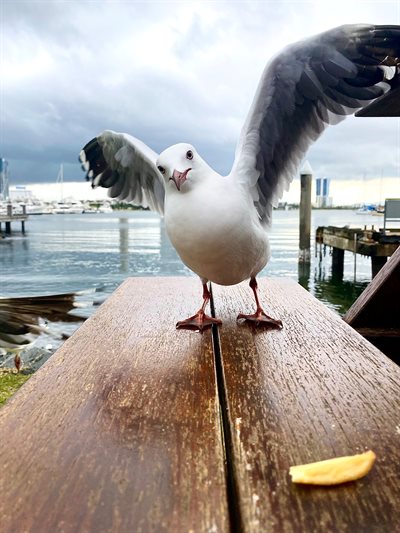Seagulls - pest control advice
Over the last 20 or so years the numbers of gulls in residential areas has increased as there is often a readily available food source in towns, no natural predators, favourable living conditions with warmer, sheltered areas compared to the countryside or coastline.
Gulls at some point visit most parts of our coastline. The closer to the coast, the more frequently gulls can be seen. Chicks generally fledge in August and then take three or four years to reach maturity and breed. The life expectancy of a Gull which reaches maturity is about 20 years. Breeding pairs court in March and commence nest building from early April onwards.
The nest can be quite large as the material used to build it can be accumulated over several years. Eggs are laid from April to May onwards with two or three being the usual number.
onwards with two or three being the usual number.
The eggs take about three to four weeks to hatch so the first chicks are generally seen about the beginning of June.
Gulls will tend to return to the same nesting site and unless action is taken to proof a building, problems associated with these birds may recur annually.
Feeding birds
If gulls are fed regularly, it creates an artificially high population and encourages further breeding pairs to take up residence in the area. A natural population level will be established only if the gulls are left to fend for themselves from natural food sources.
We strongly urge residents not to feed seagulls as this will cause more harm in the long term and can also cause unnecessary annoyance to neighbours.The practice should also be discouraged because it attracts rats.
The Law
Gulls are protected under the Wildlife and Countryside Act 1981 and are not classed as vermin. It is an offence to kill or injure any birds or their nests or eggs unless acting under alicence and only in compliance with the conditions of that licence. General licences are issued by the Welsh Government (WG) to allow measures to be taken against certain common speciesof birds on grounds which include the preservation of public health or public safety.
Any action taken must be humane and the use of an inhumane method which could cause suffering could be an offence under the Animal Welfare Act 2006. The use of poisons or drugs to take or kill any bird isspecifically prohibited except under very special circumstances and with a specific licence issued by WG.
It is only the Lesser Blackbacked and Herring Gulls where a licence can issued for humane control. However, only the owner of a building or the occupier can take action against the Gulls on it, or they can give someone else permission toact on their behalf. Herring Gulls especially like nesting on flat rooftops,and chimneys and gullies in sloping roofs.
In practice, there are very few humane methods to kill birds which are likely only to affect a particular species, and skill and experience is needed to deploy them. The Council would discourage people from themselves attempting to kill Herring Gulls which nest on their property.
Gulls on rooftops
Herring Gulls especially like nesting on flat rooftops, and chimneys and gullies in sloping roofs. It is quite common for young gulls of various ages to fall down chimneys or off roofs into gardens or onto the road. As far as possible, chicks should not be interfered with even if they have fallen from the nest. Where possible, leave it where it is as the parents will continue to look after it. It is not feasible to raise chicks without creating a dependent adult, unafraid of humans. Remember that most juveniles will take up to 48 hours to fly properly.
Gulls quite often land on the ground from a roof, and can be seen flapping their wings but not flying. These birds have probably tried flying a bit too early or are unsure of their ability to take off. They should only be taken into care if they are injured, keep falling off the roof or are in danger, in which case the Council would recommend you contact a local wildlife rescue service.
Aggression
The Herring Gull may be perceived as aggressive in certain situations. They appear more threatening than they actually are. This apparent aggressiveness is often seen in areas where food is regularly and freely available. Herring Gulls are very competitive with fellow Herring Gulls for food and for that reason may try to take food before it is thrown or discarded, for example, snatching food from a child’s hand.
Herring Gulls may also naturally protect their nests or young by performing a series of swooping dives over an intruder. While it is a disconcerting experience, a raised arm will in most case be sufficient to deter them.
Preventing Nesting or Perching Gulls
Gulls can be prevented from nesting depending on the roofdesign. After the breeding season when the nest has beenabandoned, it can be removed and deterrents for nextseason can be put into place.
The principle methods of detterence are:
- Fitting of wires or nets to prevent Herring Gulls landing.
- Fitting of short spikes, contained in a special plastic base, to nesting locations such as dormer roofs.
- Fitting of long spikes to nesting locations such as chimney stacks.
- Disturbance of nesting sites including removal or replacement of eggs and nest which should only be carriedout by a licensed company
Our Pest Control Officers can provide advice, however, we do not offer a service for gulls and would refer residents to licenced private contractors. Private pest control companies will provide a service for a fee. The Council is unable to recommend companies, but when choosing a contractor, you should always check if they are members of a recognized trade association.